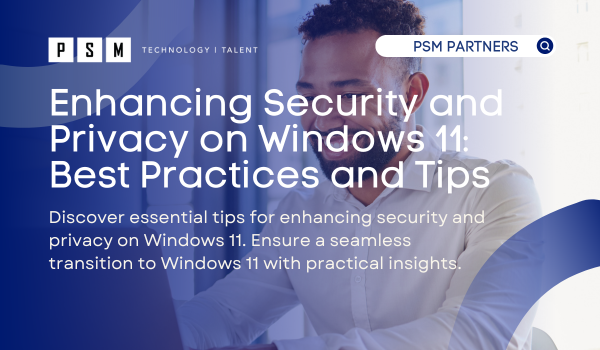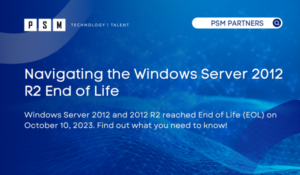Table of Contents
ToggleWith the end of life support for Microsoft’s Office 2016 and Office 2019, it’s crucial for businesses to prioritize data security and privacy measures. Securing data is paramount to safeguarding both company and client information. A recent survey revealed that merely 26.6% of devices have upgraded to Windows 11, the latest version of Windows. This concerning figure underscores the heightened risk of security incidents for organizations relying on unsupported software. To address these risks, businesses can implement various strategies and tools aimed at enhancing data protection and privacy. One such tool is the advanced app settings, which allow users to manage synchronization features and control sharing preferences across multiple devices using a Microsoft account. In this blog post, we will delve into the critical importance of data and privacy protection, explore best practices for safeguarding data, and provide actionable tips on configuring Windows 11 to meet the specific needs of businesses. Protecting data is not just about compliance; it’s about ensuring the continuity and trust of operations. By adopting proactive strategies and leveraging advanced tools, organizations can enhance their cybersecurity posture and mitigate potential security vulnerabilities effectively. Join us as we explore key insights and practical recommendations to safeguard your business in today’s evolving digital landscape.
What is Windows 11? Microsoft Account, Security Features & System Requirements Explained
Windows 11 is the most recent version of Microsoft’s desktop operating system. Windows 11 was released to the public in 2021, but adoption rates have been slow to adopt because businesses have struggled to upgrade their existing machines to meet the specific requirements outlined by Microsoft for Windows 11 compatibility. The transition to Windows 11 involves certain hardware and system specifications that many organizations have found challenging to fulfill, particularly on older devices. This has resulted in a slower uptake of Windows 11 across business networks compared to previous Windows releases.
To address these adoption challenges, businesses are exploring various strategies such as hardware upgrades, compatibility assessments, and migration plans to ensure a smooth transition to Windows 11 while maintaining operational efficiency and data security. Efforts to overcome these obstacles are essential for organizations aiming to leverage the latest features and security enhancements offered by Windows 11. Additionally, businesses need to adjust privacy settings for desktop apps like Word or Excel separately from built-in Windows apps to control their access to location data.
Windows 11 Security Features in the Settings App
Secure Boot and TPM: To successfully install Windows 11 on your PC, it is crucial to ensure that your system meets the required specifications. Windows 11 requires an advanced processor (such as Intel 8th-generation or AMD Ryzen 3000 series or newer) and must possess two security features: Secure Boot and a Trusted Platform Module (TPM).
Secure Boot is essential for Windows 11 installation, as it allows the computer’s core software to detect and hinder any modified operating system by verifying its cryptographic signatures.
TPM is another major requirement for Windows 11.TPM, which is responsible for securely storing encryption keys, certificates, and executing the secure creation and control of new keys. This feature enhances system security and integrity.
Ensure that your PC meets these hardware requirements and has both Secure Boot and TPM enabled in the BIOS settings before proceeding with Windows 11. This will ensure a smooth and successful installation process without encountering compatibility issues.
Virtualization-Based Security (VBS): Another essential hardware requirement for compatibility with Windows 11 is virtualization-based security (VBS). This technology operates by executing specific parts of the Windows operating system in isolated virtual machines. Each virtual machine utilizes its dedicated portion of working memory to ensure that critical system components are protected from unauthorized access. By reducing critical system functions into separate virtual environments, VBS reduces the risk of security breaches that could compromise system integrity. Certain features, like speech recognition and syncing settings, involve data being sent to Microsoft’s servers. VBS is a crucial component of safeguarding Windows 11 against potential security threats, making it an essential hardware tool for ensuring a secure and robust computing experience.
Understanding Windows 11 Privacy Settings
Windows 11 is designed to offer a personalized and secure user experience, but this often involves collecting various types of data. Understanding what data is collected and how it is used can help you make informed decisions about your privacy settings.
What Data Does Windows 11 Collect?
Windows 11 collects several types of data to improve functionality and security:
Diagnostic Data: This includes information about your device’s hardware and software specifications, as well as data on how you use Windows 11. This helps Microsoft identify and fix issues, ensuring a smoother user experience.
Activity Data: This encompasses details about your interactions with Windows 11, such as which apps you use, how frequently you use them, and your interaction patterns. This data helps in providing locally relevant content and enhanced error reporting.
Location Data: Your device’s location information is used to offer location-based services and features, enhancing the overall user experience.
Advertising ID: A unique identifier assigned to your device, which app developers and advertising networks use to provide more relevant advertising within apps.
App Permissions: Information about which apps have access to your device’s camera, microphone, location, and other features. This helps in managing app-specific permissions and ensuring your data is used appropriately.
By understanding these data types, you can better manage your privacy settings and control what information is shared with Microsoft.
Managing Microsoft Account and Data
Using a Microsoft account with Windows 11 offers seamless integration with various Microsoft services, but it also means sharing more data with Microsoft. If you prefer to limit data collection, you can opt for a local account instead.
Using a Local Account Instead of a Microsoft Account
Switching to a local account allows you to use Windows 11 without signing in with a Microsoft account, thereby reducing the amount of data shared with Microsoft. Here’s how you can switch to a local account:
Go to Settings: Click on the Windows icon, then select the gear icon to open the Settings app.
Navigate to Accounts: In the Settings app, go to Accounts > Your email and accounts.
Switch to Local Account: Click on “Sign in with a local account instead” and follow the prompts to create a local account.
Keep in mind that using a local account will limit access to certain features and services, such as OneDrive storage and the ability to download and install apps from the Microsoft Store. However, it provides greater control over your data and privacy.
Controlling Diagnostic Data and Feedback
Windows 11 offers several options for managing diagnostic data and feedback through the Settings app. Adjusting these settings can help you maintain better control over your data.
Managing Diagnostic Data in the Settings App
To manage diagnostic data and feedback, follow these steps:
Open Settings: Click on the Windows icon and select the gear icon to open the Settings app.
Navigate to Privacy & Security: In the Settings app, go to Privacy & security > Diagnostics & Feedback.
Choose Diagnostic Data Setting: You can select either Basic or Full diagnostic data. Basic diagnostic data includes essential information about your device and usage, while Full diagnostic data provides more detailed insights.
Send Optional Diagnostic Data: Decide whether to send optional diagnostic data, which includes additional information about your device and usage patterns.
Delete Diagnostic Data: If you wish to remove previously collected diagnostic data, click on “Delete” to clear this information.
By managing these settings, you can control the amount of data shared with Microsoft, enhancing your privacy while still benefiting from the features and security updates that Windows 11 offers.
By following these steps and understanding the privacy settings available in Windows 11, you can better protect your data and ensure a more secure computing experience.
How to Protect Your Data Privacy with Windows 11 Optional Diagnostic Data
To safeguard your data in Windows 11, you can customize your privacy settings according to your preferences. To access the privacy settings on your computer, follow these steps:
Start menu: Click the Windows icon.
Settings: Click the gear icon.
Privacy dashboard: Find and select ‘Privacy & Security’ from the navigation menu on the left-hand side.
Once you access the privacy and security settings, you can customize the following options:
Windows Permissions: Within Windows Permissions, you can manage the General settings, including the Advertising ID, a unique identifier that can be used for tracking if enabled. You can also enable or disable advanced online speech recognition that sends your speech data to Microsoft’s servers. Additionally, you can adjust Inking and typing personalization to determine whether Windows should create a personalized dictionary for you. These settings can also affect user experience in apps like Microsoft Edge.
App Permissions: Within App Permissions, you can manage a range of permissions associated with applications on Windows 11. This includes controlling access to your device’s location data, which allows or disables location-based services depending on your privacy preferences. Additionally, you can modify permissions for camera and microphone access, allowing apps to utilize features such as video calling and voice commands; these settings can be tailored on a per-app basis. Additionally, you can govern whether apps have access to your messages, notifications, and account details stored on the device, enabling personalized notifications and app-specific account interactions based on your preferences. Users can also control tracking app launches to improve their Start menu and search results.
By customizing these settings, you can significantly enhance the privacy of your data and minimize potential security threats associated with unauthorized access to sensitive information. It’s important to review and adjust these settings based on your privacy preferences and the specific needs of your device usage.
Maximize Your Windows 11 Deployment and Cybersecurity with PSM Partners
Transition smoothly to Windows 11 with PSM Partners before Windows 10 support ends in October 2025. Benefit from enhanced security and productivity features by partnering with us. Our skilled team conducts readiness assessments and creates tailored migration plans to optimize your resources. Using our real-world experience, with over tens of thousands of devices, we focus on treating all users with a white glove approach, ensuring their transition is smooth while overcoming migration challenges, regardless of your IT environment size. Synchronizing software settings and activities between different devices signed into the same Microsoft account can further enhance user experience by allowing seamless data sharing and activity resumption across devices.
PSM Partners also offers comprehensive cybersecurity services. Choose from our managed services, including monitoring, maintenance, and updates, or opt for Security as a Service (SECaaS) focused solely on system security.
Contact us today to learn more about our Windows 11 deployment and cybersecurity solutions. Let PSM Partners assist you in navigating the transition efficiently and securing your IT infrastructure.
Related Insights
Windows 10 & Exchange Server: Get Ready for October 2025 End-of-Life
At this point, most organizations should be aware of the...
Read MoreNavigating the Windows Server 2012 R2 End of Life: Key Steps to Take
In late 2023, Microsoft Windows Server 2012 and 2012 R2...
Read MoreEnhancing Security and Privacy on Windows 11: Best Practices and Tips
With the end of life support for Microsoft’s Office 2016...
Read MoreThe Impact of Ongoing PC Refreshes on Productivity and Performance
In today’s fast-paced digital world, technology is the lifeblood of...
Read MoreAbout the Author

Taylor Friend
I'm a goal-oriented Strategic Alliance Manager who is enthusiastic about building and nurturing collaborative relationships that drive business success. My commitment lies in establishing, overseeing, and expanding partnerships that generate greater business opportunities and foster revenue growth for all stakeholders.





